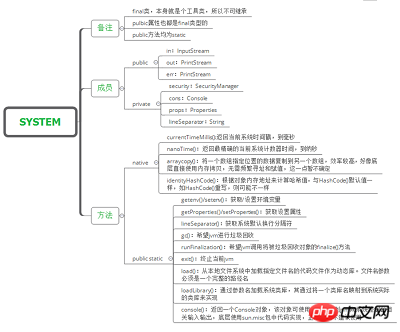
The
System class is a tool class provided by jdk. It is modified with final and cannot be inherited. As can be seen from the name, most of the operations are related to the system. This article mainly introduces the detailed explanation of the Java System class_Compiled by the Power Node Java Academy. Friends in need can refer to it
The System class is a tool class provided by jdk. It has final modification and cannot be inherited. You can see it from the name. Come out, most of the operations are related to the system. Its main functions are as follows:
• Standard input and output, such as out, in, err
• Access to externally defined attributes and environment variables , such as getenv()/setenv() and getProperties()/setProperties()
• Methods for loading files and class libraries, such as load() and loadLibrary(),
• A quick Method of copying an array: arraycopy()
• Some jvm operations, such as gc(), runFinalization(), exit(), this part is not mentioned in the java doc of the source code, maybe because it is not recommended. Take the initiative to call it. Moreover, these methods are only calls to Runtime.getRuntime(). There is no difference between the two. Look directly at the picture below. The main methods and functions have been listed.

# Next we focus on how this class is initialized. First of all, we can look at the following code at the beginning: The
static code block in the private static native void registerNatives();
static {
registerNatives();
}
private static void initializeSystemClass() {
// 初始化props
props = new Properties();
initProperties(props);
sun.misc.VM.saveAndRemoveProperties(props);
//获取系统相关的换行符
lineSeparator = props.getProperty("line.separator");
sun.misc.Version.init();
//分别创建in、out、err的实例对象,并通过setXX0()初始化,查看setXX0()方法可知,这是个native方法,将系统的标准流管理到类内的对象
FileInputStream fdIn = new FileInputStream(FileDescriptor.in);
FileOutputStream fdOut = new FileOutputStream(FileDescriptor.out);
FileOutputStream fdErr = new FileOutputStream(FileDescriptor.err);
setIn0(new BufferedInputStream(fdIn));
setOut0(new PrintStream(new BufferedOutputStream(fdOut, 128), true));
setErr0(new PrintStream(new BufferedOutputStream(fdErr, 128), true));
//加载zip包以获取java.util.zip.ZipFile这个类,以便之后加载利库使用
loadLibrary("zip");
// 设置平台相关的信号处理
Terminator.setup();
// 初始化sun.misc相关的环境变量
sun.misc.VM.initializeOSEnvironment();
// 主线程不会在同一个线程组中添加相同的线程,我们必须在这里自己实现。注释半天没弄明白,看代码就是主线程自己把自己加到了自己的线程组中......
Thread current = Thread.currentThread();
current.getThreadGroup().add(current);
// 注册共享秘钥?注释没看明白,该方法就是实例化一个JavaLangAccess
setJavaLangAccess();
// 子系统在初始化的时候可以调用sun.misc.VM.isBooted(),以保证在application类加载器启动前不做任何事。booted()其实就是改了个状态,使isBooted()变为true。
sun.misc.VM.booted();
}The above is the detailed content of Detailed explanation of System class in Java. For more information, please follow other related articles on the PHP Chinese website!




